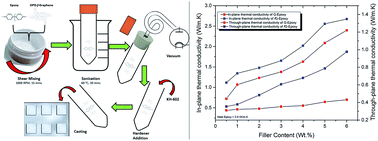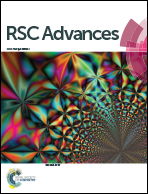Functionalization of mild oxidized graphene with O-phenylenediamine for highly thermally conductive and thermally stable epoxy composites†
Abstract
In this study, an effective and novel method was developed to improve the thermal conductivity of epoxy composites by functionalization of graphene. The functionalization of graphene was carried out with a simple refluxing method using a double N-precursor with O-phenylenediamine (OPD), in which the graphene was first treated with acid (2 : 6 molar H2SO4 : HNO3) to form oxygen containing groups on the graphene surface (O-graphene). Amidation and nucleophilic addition reactions through amine groups in OPD contributed significantly to the doping of nitrogen into the graphene layers. The OPD functionalized graphene (OPD-f-graphene) was highly effective and compatible with an epoxy matrix, resulting in homogenous dispersion of a filler in the matrix. The in-plane and through-plane thermal conductivity of the functionalized graphene filled epoxy composite (fG–epoxy) was significantly increased ∼13 fold and ∼4.8 fold, respectively, in comparison to the neat epoxy composite (G–epoxy) with the addition of 6 wt% of the filler. This improvement in thermal conductivity was attributed to better dispersion of the filler into fG–epoxy which generated phonon conduction pathways.


 Please wait while we load your content...
Please wait while we load your content...